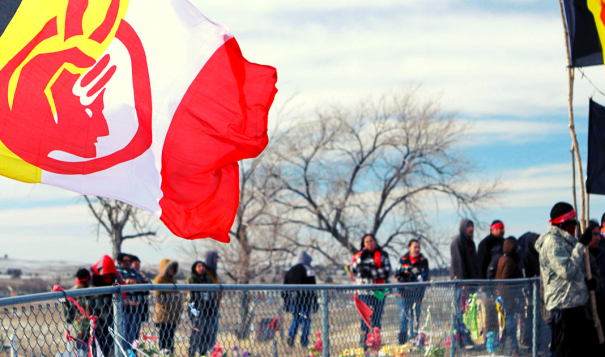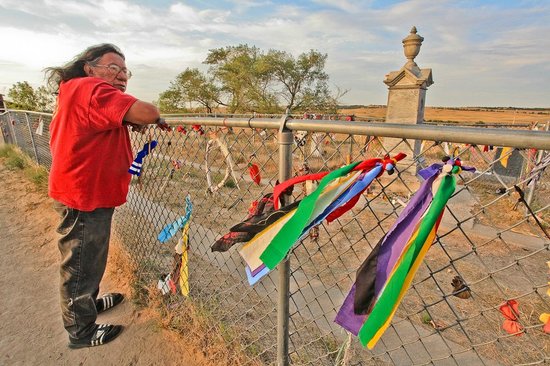 Participants in the 4 Direction Walk to Wounded Knee, South Dakota, in February 2014 native american flag
Participants in the 4 Direction Walk to Wounded Knee, South Dakota, in February 2014 native american flag
Photo above: Participants in the 4 Direction Walk to Wounded Knee, South Dakota, in February 2014. Photo by Confrontational Media via Flickr
By TIM GIAGO | Native Sun News Today
WOUNDED KNEE – In the 1920s the Gildersleeve family, Clive and Agnes (Ojibwe), built a store at Wounded Knee that sold canned goods, had a butcher shop that cut meat fresh daily, bread and milk was sold there and there were gas pumps out in front to enable the Indian people driving their Model T and Model A Fords a place to fill up their cars. More likely than not in those days one saw teams of horses pulling wagons in front of the store.
Their store also housed a United States Post Office and benches on the front porch for the Lakota elders to sit, smoke and visit. They named their store The Wounded Knee Trading Post even though the Bureau of Indian Affairs had been changed to Brennan in hopes of eradicating the name Wounded Knee.
And it was indeed a trading post. Renowned Lakota artists like Hobart Keith, Andrew Standing Soldier, Jake Herman, Vincent Hunts Horse, Paha Ska, Richard Red Owl, and Felix Walker brought their paintings to the store and sold them on consignment. Walker is the artist who painted the pillars and spirals in the old Holy Rosary Mission Church at Pine Ridge. His full Lakota name was Felix Walks Under the Ground and Comes Up Holy Two Sticks.
In later years Agnes Afraid of Hawk and her daughter Belva worked at the store creating intricate beadwork which they in turn sold at the store. Joe Spotted Horse, Howard Wounded Horse, and Patricia Pumpkin Seed also worked in and around the store as did my father Tim Giago, Sr. Tour busses would come to the store and the Lakota residents would make money for the winter by selling their arts, crafts and beadwork to the tourists. They were entrepreneurs and not exploiters.
Wounded Knee was a place where so much of my young life was shaped. It was a place where my family was all together… It was a place that held all of my memories of a good life.
There were several cabins built by the Gildersleeves for their employees and I lived in one of them with my mother, father and siblings. In 1968 when Jim Czywczynski bought the store from the Gildersleeves he remodeled some of the cabins and let his employees stay there rent free. In fact Agnes Afraid of Hawk did much of her beadwork in his home.
In the summer the main and only street leading through the community was filled with happy, laughing children playing catch or stick ball. The daughter of Clive and Agnes, JoAnne, would be riding her tricycle on the sidewalk in front of the store and I would usually be standing on the back of it pushing her along with one foot. Wounded Knee was a wonderful place to live and play.
As children we would walk along the banks of Wounded Knee Creek and pick choke cherries, plums and currents and my mother and the other women in the village would make jams and jellies and the one thing all of the children loved: wojapi (a berry pudding). Back then there was water in the creek and we would catch tadpoles and frogs.
One day, a few days after Christmas in 1938 when my siblings were home on vacation from the Indian mission boarding school, my mother Lupe had my older sisters gather sage. She took the sage and made small bundles out of them and tied them with colorful ribbons. She then took more of the ribbon and filled them with tobacco and made bundles.
The next morning my dad pulled up in front of our cabin driving the Wounded Knee Trading Post Model A Pickup, loaded us all on board and drove the couple of miles to the site of the mass grave where the victims of the Wounded Knee Massacre were buried. When we got there my father prayed and we took the prayer bundles and sage and laid them on the gravesite. It would have been the 48th anniversary of the Massacre and it is hard to believe that we just commemorated the 129th anniversary in December.
On that cold December morning in 1938 there were other Lakota families gathered at the gravesite to leave prayer bundles and to pray. My father went to some of them and shook hands as they spoke softly and reverently in Lakota. After the ceremonies many of the Lakota people went down to the Trading Post for a cup of coffee or a cold soda.
From the 1920s until Wounded Knee Village was burned to the ground in 1973 in a militant takeover, it was a wonderful place to live. My brother, sisters and the other children living in the village often kicked a soccer ball up and down the dusty street in front of the Trading Post. We played Annie, Annie Over as we tossed a ball over the roofs of the cabins.
As children we knew something terrible had happened at Wounded Knee and we respected and honored those who had died there, but Wounded Knee was our home and these were some of the happiest days of our lives living there.

Lakota Sioux tribal spokesman Milo Yellowhair, at the Wounded Knee Monument
Leonard Little Finger, a respected Lakota elder who passed away recently, a man who was a descendant of a family that died there asked me a question over lunch on evening. He asked, “What is your connection to Wounded Knee?” I said simply, “As a boy I lived there, I am a former resident.” But after considering it I know that it was much more than that. Wounded Knee was a place where so much of my young life was shaped. It was a place where my family was all together before the World War II came and we moved to Rapid City. It was a place that held all of my memories of a good life.
My sister Lillian and I are the only two children out of seven that are still alive and like me she remembers Wounded Knee as a place where she had her happiest memories. In a spiritual way, many of my childhood memories are still buried at Wounded Knee. My sister Ethel, now deceased, was born at Wounded Knee.
The village of Wounded Knee was destroyed in 1973. Fearing that it would be destroyed again if he rebuilt it, Jim Czywczynski, although he still owns the land, decided to not to rebuild.
And so it sits with only a stone chimney standing all alone to remind us that there was once a peaceful village there. The elder Gildersleeves have passed away as has my father Tim and most of the original Lakota people who once lived there. When Wounded Knee was destroyed in 1973 it broke the hearts of so many Lakota people who lived and laughed there so many years ago.
This story was originally published on Native Sun News Today. They are a subscription news service. Read their original article on the village called Wounded Knee. Tim Giago, an Oglala Lakota, was born, raised and educated on the Pine Ridge Indian Reservation and can be reached at najournalist1@gmail.com.
